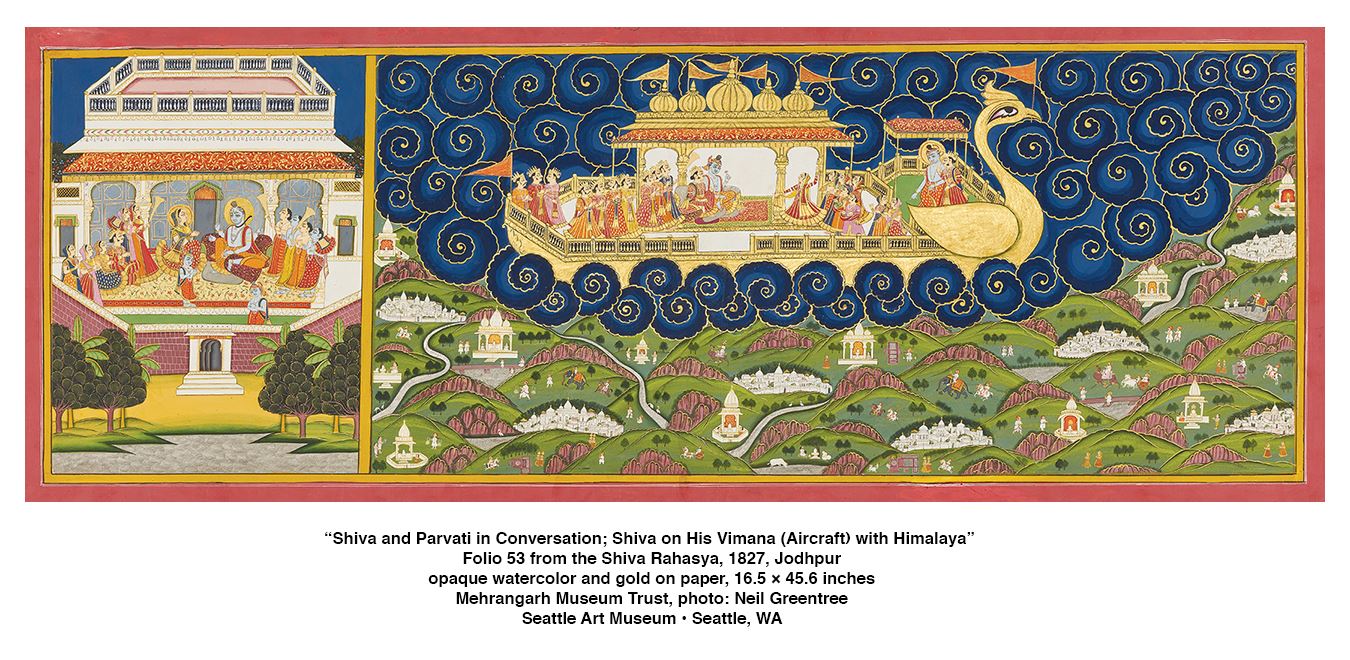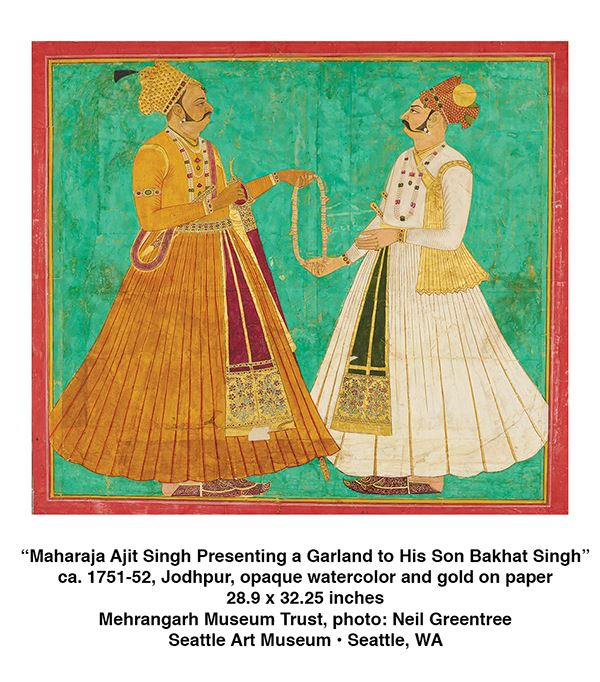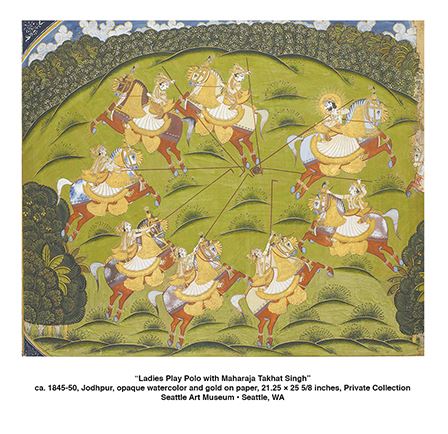
“Peacock in the Desert: The Royal Arts of Jodhpur, India”
Seattle welcomes from Jodhpur, the capital of colorful Rajasthan, the largest collection of objects from a royal kingdom ever to leave India! “Peacock in the Desert: The Royal Arts of Jodhpur, India,” on loan from The Mehrangarh Museum Trust, fills the fourth floor special exhibition galleries of the Seattle Art Museum. But it starts with an immersive wedding installation on the third floor!
The installation, based on a royal wedding procession of the “homecoming” of the bride, includes an elephant mannequin with a gilded ‘howdah’ and elaborate adornments, as well as horse mannequins with full regalia and jewelry. The bride would be hidden from view in a curtained palanquin. Video projections present the procession of the 2010 marriage of Yuvrain Gayatri kumari Pal from the former royal family of Askot in the Himalayan foothills to Yuvraj Shivraj Singh son of the current Majarajah. A wall of famous “paag” or turbans contain many layers of symbolism and make the most of the double height gallery. 
The current Maharajah His Highness GajSingh II ascended to the throne at the age of 4. Adapting to many changes in the status of the former Princely States, he has succeeded in reinventing his role as a private citizen. Reflecting his ability to innovate while honoring tradition, one major theme of this exhibition is “tradition and continuity.” The royal homecoming procession is one example of that.
At the entrance to the fourth floor gallery stunning photographs present the landscape in Marwar-Jodhpur as well as the history of the Rathores who ruled from the 13th to the mid 20th century. In the same gallery a dramatic gilded palanquin evokes royal processions and a large cradle for Krishna makes a reference to spiritual loyalties.
As we enter the “The Rathores of Marwar” paintings depict the descent of the Rathore kings from the Hindu god Rama as well as worship of the Goddess Devi and many portraits of the Maharajas.
“Conquest and Alliance: The Rathores and the Mughals” presents the long relationship with the Mughals both in battle and in court, through intermarriage and cultural exchanges. For example, the builder of the Taj Mahal, Shah Jahan, is the son of the marriage of Akbar’s son and a Rajput princess. In this gallery a full scale 17th century Indian court tent Lal Dera fills the space, alongside references to military weapons and other objects exchanged or altered by the many years of serving in Mughal campaigns all over India.
 The wedding installation links to the theme of the “Zenana: Cross Cultural Encounters” the role of women as bearers of culture. Far from simply being enclosed in the “Zenana” or women’s quarters, royal women brought new cultural traditions when they married into the Jodhpur court. The Zenana here features a full pavilion, as well as textiles, jewels, and dresses and invokes the musicians, dancers, and artists who lived or visited the women of the court. A personal shrine to Krishna made of silver includes a small statue of the deity: it was the focus of a daily ritual.
The wedding installation links to the theme of the “Zenana: Cross Cultural Encounters” the role of women as bearers of culture. Far from simply being enclosed in the “Zenana” or women’s quarters, royal women brought new cultural traditions when they married into the Jodhpur court. The Zenana here features a full pavilion, as well as textiles, jewels, and dresses and invokes the musicians, dancers, and artists who lived or visited the women of the court. A personal shrine to Krishna made of silver includes a small statue of the deity: it was the focus of a daily ritual.
The “Durbar: Rathore Court” marks the era after 1707 when the Rathores were liberated from Mughal control as the Mughals weakened. Many artists came to Jodhpur from the Mughal Courts leading to a flowering of creativity in painting, textiles, tents, arms, and jewelry.
In a sequence of alcoves, a selection of devotional paintings introduces Krishna and his familiar frolics with gopis, but don’t miss in this gallery the trademark watercolor of the exhibition, “Shiva on his Vimana” (aircraft!—a huge bird).
The last section of the exhibition “The Raj” presents the final diplomatic and cultural exchange of the princely court, with the British Empire. All of the princely states worked with the Raj, rather than resisting it. We see this most obviously in the portraits and photographs of the Maharajahs of this era, with dress and jewelry that bring together traditions from India and Great Britain. 
Also showing cultural exchange is the Umaid Bahwan palace where the family now lives, designed in the 1920s by Henry Lanchester, an English architect, who combined Art Deco and Indian motifs. A large part of the palace today is a hotel, another innovation of the current Maharajah. He has been a major catalyst for tourism in Jodhpur by renovating the Mehrangarh Museum, not to mention sending this exhibition to the United States (it is making only three stops).
“Peacock in the Desert” is a perfect title for the exhibition. The exhibition, like India itself, is full of elaborate objects, stunning color, and fascinating history. To expand our experience, the museum has organized a film series, a Diwali family festival, presentations on South Indian court dance and saris, and a program on the “Songs of Rajasthan.” Check the museum website for more details.
Susan Noyes Platt
Susan Noyes Platt writes a blog www.artandpoliticsnow.com and for local, national, and international publications. “Peacock in the Desert: The Royal Arts of Jodhpur, India,” is on view until January 21 at Seattle Art Museum, located at 1300 First Avenue in Seattle, Washington, Friday through Wednesday from 10 A.M. to 5 P.M. and Thursday from 10 A.M. to 9 P.M. For more information, visit www.seattleartmuseum.org.